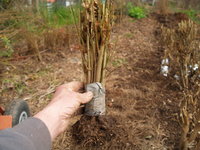Shibui
Imperial Masterpiece
Some examples of trident maples developed by fusing several seedlings to get a thicker trunk.
This one has been in the grow beds for a couple of years now trying to get the main trunk to fuse properly. The second trunk has united well but there's still gaps in the larger trunk.


Roots trimmed. The mass of fine roots is the result of annual hard root pruning. Even when they are in the grow bed tridents are dug every winter and root pruned. This not only results in mass of lateral feeder roots but also makes digging so much easier than having to saw through thick roots and chop lots of thick vertical roots.

Preliminary top prune.

Shots showing the gaps between the individual seedlings where they have not fused. Not sure whether to give it a few more years or to throw this one away.


Final pruning. I've decided to give it another chance. I'll let the trunks that need to thicken to fuse free run next summer but try to keep the rest more contained.

There are more of these trial trees in the grow beds. I'll try to remember to take photos as I dig them and add here.
Others are welcome to add similar fused trunk bonsai - successful or not.
This one has been in the grow beds for a couple of years now trying to get the main trunk to fuse properly. The second trunk has united well but there's still gaps in the larger trunk.


Roots trimmed. The mass of fine roots is the result of annual hard root pruning. Even when they are in the grow bed tridents are dug every winter and root pruned. This not only results in mass of lateral feeder roots but also makes digging so much easier than having to saw through thick roots and chop lots of thick vertical roots.

Preliminary top prune.

Shots showing the gaps between the individual seedlings where they have not fused. Not sure whether to give it a few more years or to throw this one away.


Final pruning. I've decided to give it another chance. I'll let the trunks that need to thicken to fuse free run next summer but try to keep the rest more contained.

There are more of these trial trees in the grow beds. I'll try to remember to take photos as I dig them and add here.
Others are welcome to add similar fused trunk bonsai - successful or not.




































